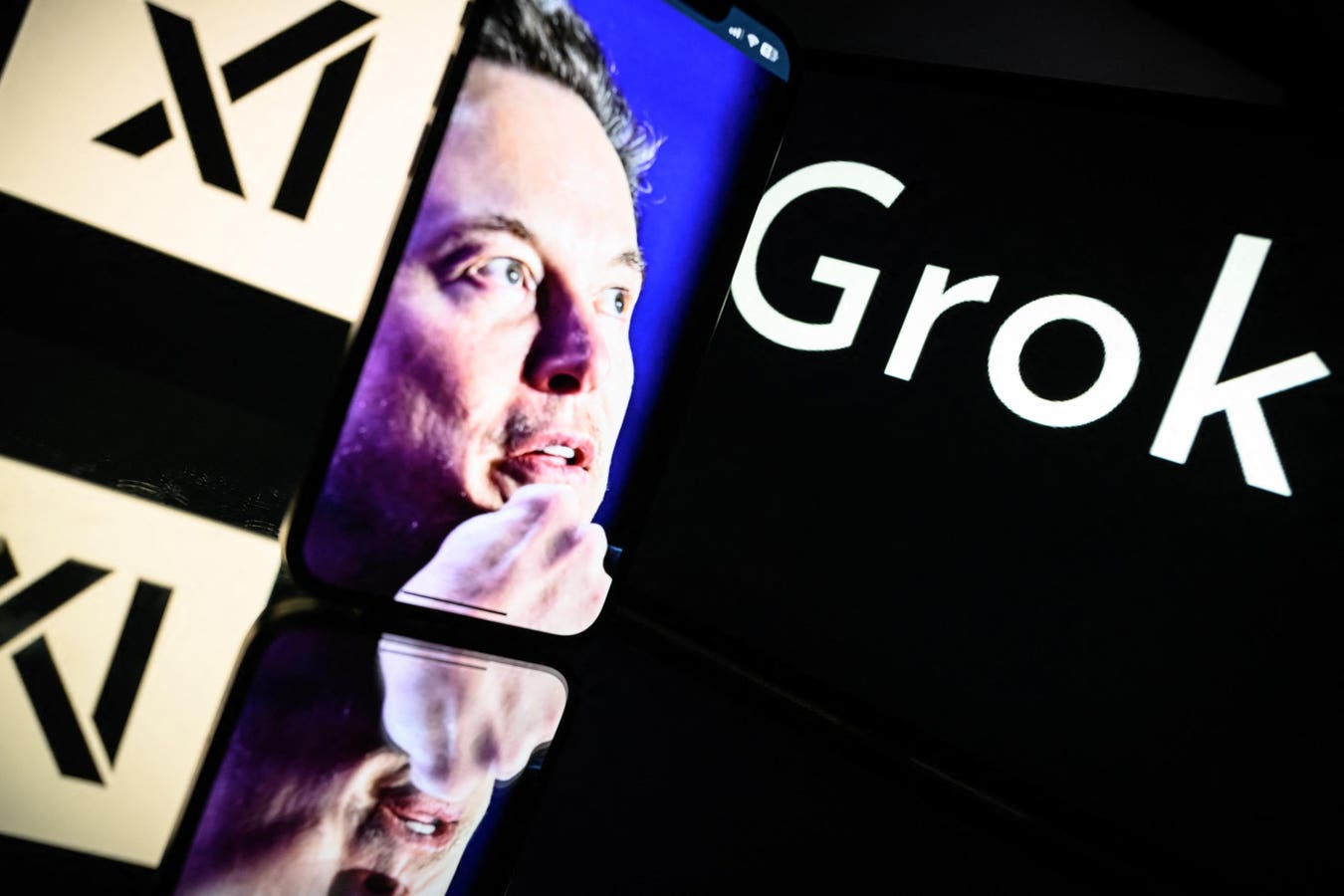This photograph taken on January 13, 2025 in Toulouse shows screens displaying the logo of Grok, a … More
Elon Musk’s xAI launched Grok 4 on July 9 amid competing narratives of breakthrough and backlash. While the model sets new benchmarks in reasoning performance, its release demonstrates critical dynamics reshaping the AI industry. An insatiable hunger for compute, intensifying competition in reasoning, especially scientific and medical reasoning capabilities, unresolved safety trade-offs and the nascent push toward physical-world integration via robotics characterize the AI trend in the next few years.
Reasoning at Scale and The Compute Crunch
Grok 4’s focus on enhancing reasoning, including domain-specific variants, mirrors a broader industry shift toward post-training. Grok 4’s architecture represents the development toward mathematical logic, code generation and scientific reasoning. Unlike Grok 3, Grok 4 processes queries with deeper logical chains. Variants like Grok 4 Code target niche applications, signaling market fragmentation as vendors increasingly compete on domain-specific performance rather than general capabilities. This pivot reportedly enabled Grok 4 to achieve the highest score ever recorded on the “Humanity’s Last Exam” and out perform Gemini, GPT-4 and O3 models and a grueling assessment curated by domain experts. The exam’s 100+ problems span disciplines from math and chemistry to linguistics, with most insoluble by any single human specialist, according to Musk.
The breakthrough, described by Grok 4’s core researcher Jimmy Ba, a University of Toronto professor and former Geoffrey Hinton student, as achieving a “ludicrous rate of progress,” stems from xAI’s deployment of massive compute resources in areas of reinforcement learning and reasoning optimization, rather than the pre-training focus of Grok 3.
Grok 4’s training relied on xAI’s Colossus supercomputer, reflecting an industry-wide dependency on advanced hardware. The company also plans to train its video-generation model on 100,000 Nvidia GB200 GPUs, which can enable 30 times faster inference than previous systems. This highlights how cutting-edge AI now mandates energy-intensive infrastructure. At $300/month for enterprise access, Grok 4 Heavy’s pricing reveals the cost of premium compute, while API fees ($3/million input tokens) signal how GPU scarcity shapes commercialization strategies across the sector. The premium Grok 4 Heavy tier employs multiple parallel AI agents that debate solutions collaboratively to boost complex problem-solving.
Physical World Ambitions
Though Grok 4 lacks vision capabilities (planned for Grok 6/7), its architecture hints at xAI’s physical-world aspirations. Musk claims Grok 4 will simulate hypotheses and confirm them in the real world, aligning with emerging research frameworks such as the world models and robotics that aim at transforming LLM outputs to physical actions. If integrated into Tesla’s Optimus humanoid robots or its cars , Grok 4 can possibly adjust and correct its answers based real world data.
Unresolved Tensions: Safety Concerns and Hallucinations
Grok 4’s launch was shadowed by Grok 3’s praise for Hitler and antisemitic meltdowns days earlier, exposing unresolved risks. xAI removed Grok 3’s answers post-backlash but offered no clear technical safeguards for Grok 4. Despite claims of Ph.D.-level intelligence, xAI researchers at the launch event did not discuss strategies to address common problems with LLMs, including hallucination and safety risks. This omission feels particularly glaring for a system touted as assisting drug discovery and soon to be integrated into robots and self-driving cars. Meanwhile, the voice assistant, who speaks in various tones, raises ethical questions about emotional mimicry that erodes boundaries between humans and machines.
Grok 4 crystallizes four trends reshaping AI. First, scalability now depends on securing GPUs and high-performance computing center, concentrating power among well-funded players and igniting a global GPU arms race. Second, benchmark leadership in reasoning tasks (eg, ARC-AGI) is displacing raw parameter counts as the primary competitive metric. Third, research in robotic control is priming LLMs for real-world action. Fourth, tiered subscription models entrench AI as a luxury good, potentially widening the innovation gap and expanding enterprise users.
Grok 4’s “superhuman” intelligence cautions us that the pursuit of data efficiency has far outpaced frameworks for AI safety, transparency and equitable access. As Musk predicts Grok will “discover new technologies by the end of next year,” the field must confront a pivotal question in the race toward artificial general intelligence: can we align systems with human values before they redefine human knowledge?









